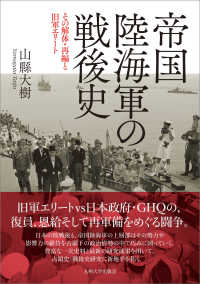- ホーム
- > 洋書
- > 英文書
- > History / American
Full Description
On July 22, 1847, a group of about forty refugees entered the Salt Lake Valley. Among them were three enslaved men, two of whom shared the religion, Mormonism, that had caused them to flee. The valley was also home to members of the Ute tribe, who would sometimes barter captive women and children to Spanish colonizers. Thus, the question of whether the Latter-day Saints would accept or reject slavery in their new Zion confronted them on the day they first arrived. Five years later, after Utah had become an American territory, its legislature was prodded to take up the question then roiling the nation: would they be slave or free?
George D. Watt, the official reporter for the 1852 legislative session, reported debates and speeches in Pitman shorthand. They remained in their original format, virtually untouched, for more than one hundred and fifty years, until LaJean Purcell Carruth transcribed them. In this eye-opening volume, Carruth, Christopher Rich, and W. Paul Reeve draw extensively on these new sources to chronicle the session, during which the legislature passed two important statutes: one that legally transformed African American slaves into "servants" but did not pass the condition of servitude on to their children and another that authorized twenty-year indentures for enslaved Native Americans.
This Abominable Slavery places these debates within the context of the nation's growing sectional divide and contextualizes the meaning of these laws in the lives of Black enslaved people and Native American indentured servants. In doing so, it sheds new light on race, religion, slavery, and unfree labor in the antebellum period.
Contents
Introduction: The 1852 Utah Territorial Legislative Session
Chapter 1: Servitude and Slavery in Antebellum America
Chapter 2: Slavery among the Latter-day Saints, 1830-1847
Chapter 3: Slavery among the Latter-day Saints, 1847-1852
Chapter 4: The Trial of Don Pedro León Luján
Chapter 5: An Act for the Relief of Indian Slaves and Prisoners
Chapter 6: An Act in Relation to Service
Chapter 7: Race and Election Law
Chapter 8: Implications
Chapter 9: Slavery, Priesthood Denial, and Brigham Young versus Orson Pratt
Chapter 10: Utah's Juneteenth
Appendix
1. Legislative Chronology, 1852
2. An Act for the Relief of Indian Slaves and Prisoners
3. An Act in Relation to Service








